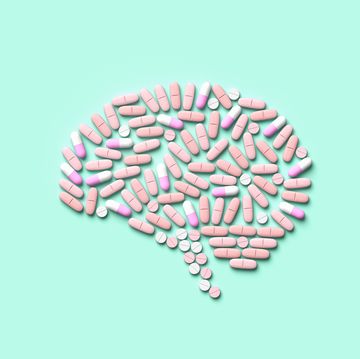The Food and Drug Administration has approved a new medication to treat migraine headaches. Zavzpret (zavegepant) is a nasal spray that can help provide pain relief in as little as 15 minutes in adults with migraines.
The medication isn’t perfect, but clinical trial results posted in the journal Lancet Neurology show that the drug performed better than a placebo at providing migraine headache relief. The study followed 1,269 patients with migraine headaches—half were given Zavzpret and half were given a placebo when they had a migraine. The researchers found that about 24% of those who took Zavzpret had no pain after 30 minutes to two hours, while 15% of those who took the placebo reported the same results.
“In many patients, traditional acute treatment options for migraine, including triptans, are either ineffective or contraindicated,” says Brittany Mays, M.D., assistant professor of neurology at the Vanderbilt University School of Medicine. “Additionally, migraine continues to affect more than 1 billion people worldwide (one in five women, and one in 16 men), and is the second leading cause of disability worldwide. Having as many tools as possible to provide acute relief and to improve quality of life is imperative.”
Angela Hwang, chief commercial officer and president of Global Biopharmaceuticals Business for Pfizer called the medication a “significant breakthrough for people with migraine who need freedom from pain and prefer alternative options to oral medications” in a press release. But it’s understandable to have questions, given that the medication helped just 24% of those dealing with migraine pain.
Here’s what you need to know about Zavzpret, plus how it works.
What is Zavzpret and how does it work?
Zavzpret is a nasal spray that’s designed to help stop migraine pain. While it’s not the first nasal spray for migraine, it uses a new approach with a treatment that tries to block the release of proteins called calcitonin gene-related peptides, which increase during a migraine attack, leading to inflammation and pain.
Zavzpret is known as a small molecule CGRP receptor antagonist, and it’s designed to be used as an alternative to other migraine treatments, including triptans, which are a different class of drugs used to treat migraine pain, Pfizer says.
How do you take Zavzpret?
Zavzpret is taken through a nasal spray. The recommended dose is 10 milligrams given as a single spray in one nostril as needed, according to the FDA. However, it’s not recommended that you take more than one spray in a 24-hour time period.
(The FDA also notes that there is no safety data on treating more than eight migraines in a 30-day period with this medication.)
Zavxpret is not designed as a preventative treatment, but can be used when someone experiences migraine with or without aura, the FDA says.
Zavzpret side effects
There are a few potential side effects of taking Zavzpret. The FDA said the following happened during the clinical trial:
- Taste disorders like dysgeusia and ageusia (18%)
- Nausea (4%)
- Nasal discomfort (3%)
- Vomiting (2%)
What do doctors think?
It’s important to note that Zavzpret wasn’t compared to other medications. “We are unable to determine if it is superior to other medications used to treat migraine, as it was only compared with placebo,” says Emily Aboujaoude, Pharm.D., clinical assistant professor at the Rutgers University Ernest Mario School of Pharmacy. “Further research is needed to confirm its efficacy relative to other treatment options.” But, that doesn’t mean Aboujaoude thinks it’s a flop. “It is definitely worth trying if other medications are intolerable, ineffective, or inconvenient,” Aboujaoude says. “However, we need further research to confirm its long-term safety and ensure consistency of its efficacy outcomes.”
Other experts are excited by the nasal spray. “I am in favor of trying nasal spray formulations,” says Elizabeth Kraus, Pharm.D., Neurology Clinical Pharmacy Specialist at Corewell Health. “Just from clinical experience, the nasal formulations will often outperform tablets for people.”
Kraus says she’s not overly impressed with the 24% success rate, but says the medication may be a better fit for people whose migraines tend to progress rapidly, those who don’t do well with oral medications, and people who struggle with severe nausea.
Amit Sachdev, M.D., M.S., medical director in the Department of Neurology at Michigan State University, says it’s helpful to have another medication available to treat migraine headaches, noting that Zavzpret can help “individuals who have substantial nausea with their migraines.”
Dr. Sachdev says the fast-acting nature of Zavzpret can be particularly helpful. “Migraines tend to escalate very quickly and are associated with nausea,” he says. “Rapid-acting and non-oral [medications] help overcome these issues.”
Dr. Sachdev acknowledges that the 24% efficacy rate isn’t ideal, though. “I would like to see more broad effect, but the current trial results wouldn’t keep me from thinking of this medication,” he says. Kraus notes, too, that the effect of Zavzpret can last up to two days, which she doesn’t see in oral medications. “If I can give someone something that will act fast and have a more lasting effect...that’s what I care about,” she says.
“Overall, it’s definitely worth trying,” says Medhat Mikhael, M.D., pain management specialist and medical director of the non-operative program at the Spine Health Center at MemorialCare Orange Coast Medical Center in Fountain Valley, Calif. “It is like any other CGRP inhibitor. It does work well for some patients, and doesn’t work for others.”
Other migraine treatments
Migraine headaches are chronic and can’t be cured, but they typically can be managed, according to the Cleveland Clinic. In general, medications are divided into two camps: abortive, which are taken at the first sign of migraine and are intended to try to help stop the migraine process, and preventive, which can help reduce the frequency and severity of migraine headaches.
There are a lot of potential medications to treat migraine headaches. For over-the-counter use, the FDA has approved Excedrin Migraine, Advil Migraine, and Motrin Migraine Pain.
The following are prescription drug options, per the Cleveland Clinic—and there are a lot:
Triptan class of drugs:
- Sumatriptan
- Zolmitriptan
- Naratriptan
Calcium channel blockers:
- Verapamil
Calcitonin gene-related (CGRP) monoclonal antibodies:
- Erenumab
- Fremanezumab
- Galcanezumab
- Eptinezumab
Beta-blockers:
- Atenolol
- Propranolol
- Nadolol
Antidepressants:
- Amitriptyline
- Nortriptyline
- Doxepin
- Venlafaxine
- Duloxetine
Antiseizure drugs:
- Valproic acid
- Topiramate
Other:
- Steroids
- Phenothiazines
- Corticosteroids
Overall, Dr. Sachdev points out that it can take time to find the right migraine treatment. “Treating migraine is largely trial and error,” he says. “Many patients need to try many medicines before they find the right fit for them.”
Zavzpret will be released in pharmacies in July, according to Pfizer.
..











